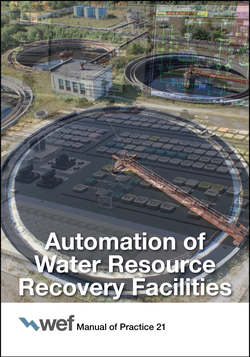Читать книгу Automation of Water Resource Recovery Facilities - Water Environment Federation - Страница 24
2.1.2 Energy Savings
ОглавлениеBenefits from energy management at a WRRF typically come from automatically controlling a process to reduce wasted energy and shifting the time of day when energy loads are used. Energy usage data from a survey of 47 wastewater utilities (Jones, 2006) shows the following breakdown: in-facility pumping, 38%; aeration, 26%; effluent reuse pumping, 25%; and “other”, 11%. Thus, pumping and aeration accounted for approximately 89% of total energy use within the surveyed wastewater facilities. These values serve as an example that data are site-specific and can vary widely from facility to facility. For example, data indicate that aeration can range from 25% to as much as 60% of total energy use (WEF, 2009).
The classic energy savings example in a WRRF is to measure the aeration dissolved oxygen and automatically adjust the blowers to maintain a dissolved oxygen setpoint. Installing automatic dissolved oxygen control can potentially save 15 to 40% of aeration energy (Hamilton et al., 2009). This is one example where automation can be used to improve aeration efficiency; although other opportunities exist for the operation of blowers over their operating range, these are beyond the scope of this chapter.
The use of variable frequency drives (VFDs) in conjunction with automation can further improve energy efficiency in some applications. Generally, systems that have varying flow demands and use valves for flow control or systems that use full-speed motors where the motor speed can be reduced while meeting the demand can provide potential energy savings applications with VFDs. For equipment that is operated occasionally, automation can be used to schedule the equipment to run during off-peak hours or sequence the operation of multiple units to reduce demand charges.
Electric utilities often provide several types of rate structures, including flat rates and rates that vary based on the time of day. Demand charges at a WRRF can account for one-third of the overall bill. Rates will vary for each electric company and will also vary by customers’ facility characteristics. Some electric utilities will provide real-time pricing rates that change daily. Energy-bill savings from automation can often be realized by shifting facility and equipment operation to periods with lower energy and demand charges.
The ability to identify power savings and load-shifting opportunities often begins by measuring real-time power usage throughout a facility. Supervisory control and data acquisition (SCADA) systems can include power monitors to monitor and track real-time and historical power consumption; they also provide displays, trends, and dashboards for understanding how the system is performing. By tracking overall power consumption, real-time control of demand can be implemented. Supervisory control and data acquisition systems can be programmed to alarm when demand is approaching the current monthly peak, and can perform preprogrammed load-shedding and load-shifting operations. The 136-ML/d (36-mgd) Encina Wastewater Treatment Plant in Carlsbad, California, modified operations to shut down selected high-demand equipment during peak hours, resulting in an annual savings of $50,000 per year (CEC, 2003).
Incorporating improvements in energy efficiency to a project can provide opportunities for energy utilities or other entities to assist in paying or financing a portion of project costs. It is important to point out that energy conservation measures need to take into account any potential effects to process performance or reliability.
